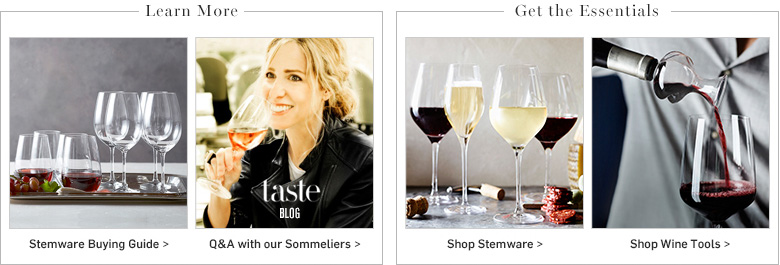
Learn everything you need to know about wine, from grape varietals and growing regions to tasting, serving and pairing with food.



Here are four steps to evaluating a wine's color, aroma and flavor, plus key terms to help you talk about it.
Hold the glass by its stem and look at the color. A white wine should be transparent and bright, while a red wine should be translucent
and saturated.
Swirl the wine by the stem, letting oxygen in and releasing the wine's aromas. Look at the "legs," the tracks on the inside of the glass – high-alcohol wines will have more pronounced ones.
With your nose over the rim of the glass, inhale long and deep through your nostrils. Younger wines have stronger, more aggressive aromas; older wines are more subdued and complex.
Fill your mouth one-third full and swish the wine around to reach all parts of your palate. Pay attention to the mouthfeel, how the wine changes as you swallow, and how long the flavor lingers.
A natural component of grapes that helps the wine achieve balance and structure, also called tartness. Too much creates sharpness; too little leads to wines that are dull and flat.
The smell of a young wine or of the grapes used to make the wine, also called bouquet.
A wine is in balance when the acidity, tannins, alcohol, sweetness and oak (if any) come together in harmony.
The feeling of substance a wine forms in the mouth, also called mouthfeel. Described in terms of weight, fullness or texture.
A very good balance with distinctive layers of aromas and flavors.
Wine that has been affected by cork taint, caused by a mold in cork bark that gives the wine an off flavor.
The opposite of sweet, with less than 0.5 percent residual sugar.
The smell of earth or soil present in a wine.
The length of time a wine's aftertaste lingers on the tongue.
The aroma of flowers in a wine, usually a white wine.
An herbaceous aroma in a wine.
Clean, grassy or herbal flavors, often attributed to young white wines.
Rich, concentrated fruit flavors, often applied to California Zinfandel and Australian Shiraz.
An aroma reminiscent of stones, chalk or mineral-laced soil in a wine, usually white, often thought to be the taste of a wine's terroir.
A rounded, viscous feeling on the palate, commonly found in oak-aged Chardonnays.
Great depth of fruit and a powerful, long finish.
The impression of a spice like pepper or anise, perceived through the nose as an aromatic element.
An astringent substance that comes from both grape skins and oak barrels and causes a dry, puckering sensation in the mouth.
The influence of every aspect of a vineyard site, including the soil, sun exposure, wind direction, vineyard microclimate and other natural elements on the wine when it is brought together with the human element. Also referred to as a wine's sense of place.
A toasted, nutty, smoky aroma in a wine, which comes from aging in oak.
An aroma of bread or bread dough, common in many sparkling wines and some still whites.


There's no better way to discover a new favorite bottle of wine than by gathering a few friends for a wine-tasting party. Here's our guide to creating the ultimate tasting experience: Choose the wines, plan your tasting and set the scene with these tips.
Pick a theme.
Tasting wines side by side helps you identify and appreciate their similarities and differences. Select wines that have something in common, ideally a grape varietal or vintage. Taste a single varietal from different years or producers, or taste wines made from the same grape in different regions. Or, focus on a single region and taste a range of the wines it produces.
Mind the order.
Taste lightest whites first, starting with sparkling wines, then move progressively to the full-bodied reds. Order whites from dry to sweet and reds from light- to full-bodied.
Keep it simple.
Serve four to six wines in a single tasting; too many, and it's harder to appreciate the subtleties of each one. You may want to buy a couple of extra bottles to serve after the tasting, too.
Taste blind.
In a blind tasting, each bottle is hidden in a numbered paper bag to conceal the label; that way, you have to rely on your senses to identify it. Sniff, sip and guess the varietal – bonus points if you get the region.
Pair with food.
The perfect food match can bring out subtle flavors in a wine. Pair wine with cheese and desserts for a fun spread to nibble on before or after dinner (see our pairing suggestions). Or, set up a full buffet with classic combinations, like smoked salmon and Champagne or burger sliders and Zinfandel.
Start a conversation.
Pass out wine-tasting charts or scorecards so guests can take notes. See our wine-tasting glossary for a list of terms to help you describe the wines.
Serve snacks.
In addition to any specific food pairings, offer bites to cleanse the palate between wines – bread or crackers – along with light snacks such as grapes, olives and nuts. Prepare a few hors d'oeuvres such as seasonal crostini or savory dips, too, so no one is tasting on an empty stomach.
Prep your space.
Depending on the types of wine you're tasting, you will need plenty of glasses: at least one sparkling, white, red and possibly dessert. Use wine charms or paper labels around the base of the glass to keep track. Don't forget a bucket for pouring out extra wine and a pitcher of water for sipping.
Decorate smarter.
Forget fragrant floral centerpieces and candles, which will only compete with the aromas of the wines. Set out bowls of fruit or arrange thin branches in glass bottles instead, and light unscented candles. Let the theme inspire the décor; use decorative leaves and bunches of fresh grapes.












